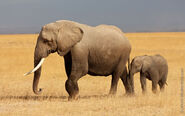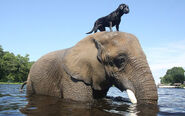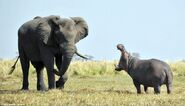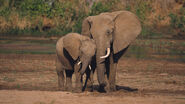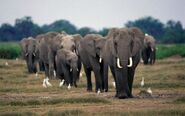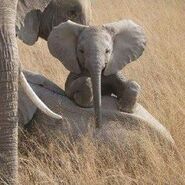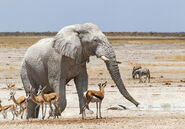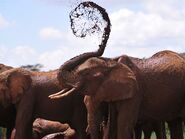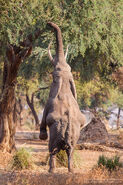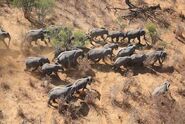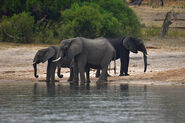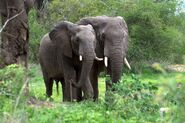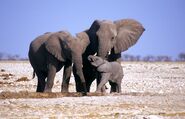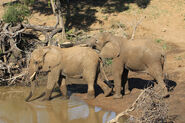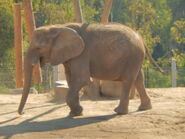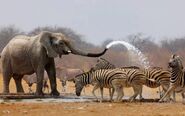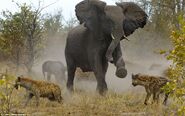m (Gaven love's animals 2004 moved page African Elephant to African Bush Elephant: Did you see there are two species of African elephants now!) |
(Adding categories) |
||
| Line 58: | Line 58: | ||
[[Category:Endangered Species]] |
[[Category:Endangered Species]] |
||
[[Category:Keystone Species]] |
[[Category:Keystone Species]] |
||
| + | [[Category:The Lion King Animals]] |
||
Revision as of 23:20, 6 October 2018

African elephants are the largest land animals on Earth. They are slightly larger than their Asian cousins and can be identified by their larger ears that look somewhat like the continent of Africa. (Asian elephants have smaller, rounded ears.)
Trunks and Tusks
Elephant ears radiate heat to help keep these large animals cool, but sometimes the African heat is too much. Elephants are fond of water and enjoy showering by sucking water into their trunks and spraying it all over themselves. Afterwards, they often spray their skin with a protective coating of dust. An elephant's trunk is actually a long nose used for smelling, breathing, trumpeting, drinking, and also for grabbing things—especially a potential meal. The trunk alone contains about 100,000 different muscles. African elephants have two fingerlike features on the end of their trunk that they can use to grab small items. (Asian elephants have one.)
Both male and female African elephants have tusks they use to dig for food and water and strip bark from trees. Males use the tusks to battle one another, but the ivory has also attracted violence of a far more dangerous sort. Because ivory is so valuable to some humans, many elephants have been killed for their tusks. This trade is illegal today, but it has not been completely eliminated, and some African elephant populations remain endangered.
Diet
Elephants eat roots, grasses, fruit, and bark, and they eat a lot of these things. An adult elephant can consume up to 300 pounds (136 kilograms) of food in a single day. These hungry animals do not sleep much, and they roam over great distances while foraging for the large quantities of food that they require to sustain their massive bodies.
Herds and Habitat
Female elephants (cows) live in family herds with their young, but adult males (bulls) tend to roam on their own or in bachelor herds. Having a baby elephant is a serious commitment. Elephants have a longer pregnancy than any other mammal—almost 22 months. Cows usually give birth to one calf every two to four years. At birth, elephants already weigh some 200 pounds (91 kilograms) and stand about 3 feet (1 meter) tall.
African elephants, unlike their Asian relatives, are not easily domesticated. They range throughout sub-Saharan Africa and the rain forests of central and West Africa. The continent’s northernmost elephants are found in Mali’s Sahel desert. The small, nomadic herd of Mali elephants migrates in a circular route through the desert in search of water.
Teeth
Elephants have four molars; each weighs about 5 kg (11 lb) and measures about 30 cm (12 in) long. As the front pair wears down and drops out in pieces, the back pair moves forward, and two new molars emerge in the back of the mouth. Elephants replace their teeth four to six times in their lifetime. At about 40 to 60 years of age, the elephant loses the last of its molars and will likely die of starvation, a common cause of death. African elephants have 24 teeth total. Six on each quadrant of the jaw. The enamel plates of the molars are fewer in number than in Asian elephants.
The elephants' tusks are firm teeth; the second set of incisors become the tusks. They are used for digging for roots and stripping the bark from trees for food; for fighting each other during mating season; and for defending themselves against predators. The tusks weigh from 23–45 kg (51–99 lb) and can be from 1.5–2.4 m (5–8 ft) long. Unlike Asian elephants, both male and female African elephants have tusks. They are curved forward and continue to grow throughout the elephant's lifetime.

